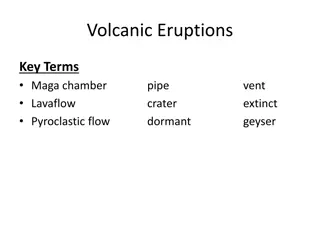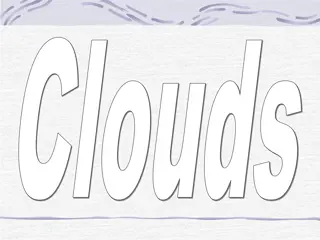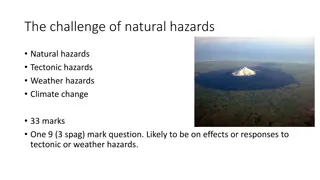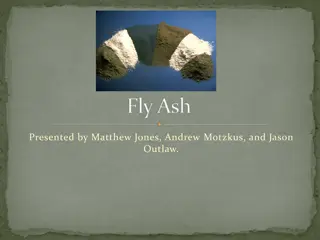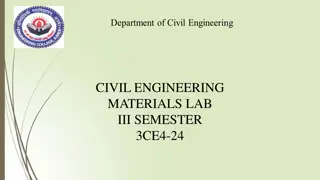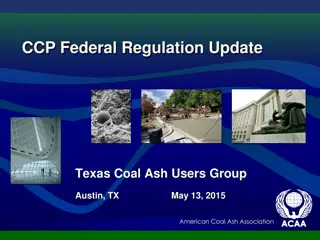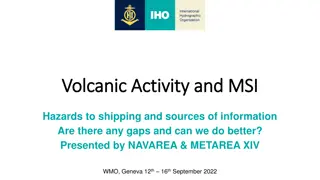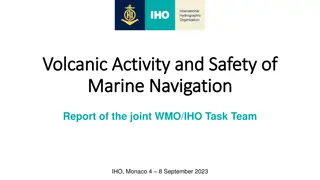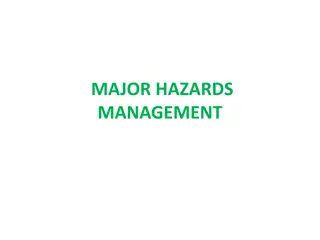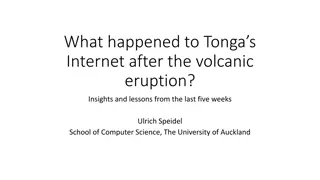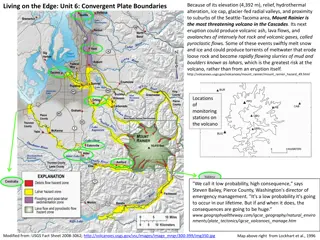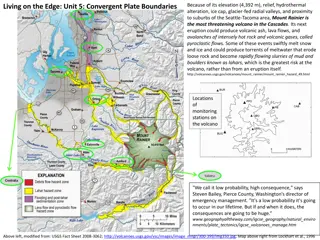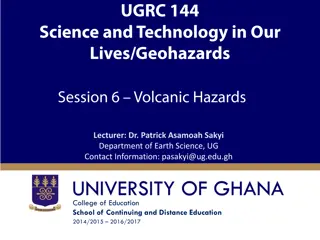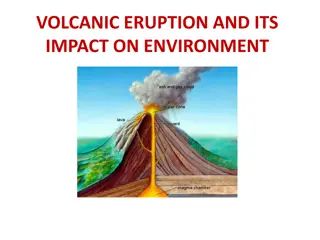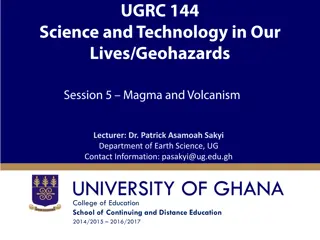Understanding Volcanic Hazards: Tephra, Ash Clouds, and Lava Flows
Explosive volcanic eruptions produce tephra, fragments of rock that can be carried by volcanic plumes, ash clouds, and lava flows. Tephra, including blocks, bombs, and lapilli, poses aviation hazards, infrastructure disruptions, and health risks. Ashfall can impact communities and agriculture over vast areas, while lava flows, depending on their viscosity and speed, can destroy everything in their path. Understanding these volcanic hazards is crucial to mitigate the potential devastation they can cause.
Uploaded on Sep 22, 2024 | 0 Views
Download Presentation

Please find below an Image/Link to download the presentation.
The content on the website is provided AS IS for your information and personal use only. It may not be sold, licensed, or shared on other websites without obtaining consent from the author. Download presentation by click this link. If you encounter any issues during the download, it is possible that the publisher has removed the file from their server.
E N D
Presentation Transcript
Tephra and Ash Clouds Explosive eruptions produce ash. All explosive volcanic eruptions generate tephra, fragments of rock that are produced when magma or rock is explosively ejected. The largest fragments, blocks and bombs (>64 mm, 2.5 inches diameter), can be expelled with great force but are deposited near the eruptive vent. Lapilli-sized material (6-64 mm, 0.24-2.5 inches diameter) can be carried upward within in a volcanic plume and downwind in a volcanic cloud, but fall to the ground as the eruption cloud cools. The smallest material, volcanic ash (<2 mm diameter) is both easily convected upward within the plume and carried downwind for very long distances; as it falls out of suspension it can potentially affect communities and farmland across hundreds, or even thousands, of square kilometers (miles). Ash endangers aviation and infrastructure. Ashfall rarely endangers human lives, but it can have devastating effects on the things that we rely upon from day to day. As a result of its fine-grained abrasive character and widespread distribution by wind, ashfall and volcanic ash clouds are a major hazard to aviation. The primary hazard from Alaska volcanoes is ash clouds impacting aviation and ashfall reaching areas downwind, owing to widespread dispersal by wind. Ash fallout to the ground can pose significant disruption and damage to buildings, transportation, water and wastewater, power supply, communications equipment, agriculture, and primary production leading to potentially substantial societal impacts and costs, even at thicknesses of only a few millimetres or inches. Additionally, fine grained ash, when ingested can cause health impacts to humans and animals. Impacts from ashfall are more complex and multi-faceted than for any of the other volcanic hazards. Variabilities include the distance from the eruption source, orientation and dispersion of the eruption cloud, the amount of ashfall received, physical and chemical properties of the ash, characteristics of the receiving environment (such as climate and land use), and the ability of affected community to adapt to ashfall.
Lava Flows Lava flows are streams of molten rock that pour or ooze from an erupting vent. Lava is erupted during either non-explosive activity or explosive lava fountains. The speed at which lava moves across the ground depends on several factors, including (1) type of lava erupted and its viscosity; (2) steepness of the ground over which it travels; (3) whether the lava flows as a broad sheet, through a confined channel, or down a lava tube; and (4) rate of lava production at the vent. Fluid basalt flows can extend tens of kilometers from an erupting vent. The leading edges of basalt flows can travel as fast as 10 km/h (6 mph) on steep slopes but they typically advance less than 1 km/h (0.27 m/s or about 1 ft/s) on gentle slopes. But when basalt lava flows are confined within a channel or lava tube on a steep slope, the main body of the flow can reach velocities >30 km/h (19 mph). Viscous andesite flows move only a few kilometers per hour (couple feet per second) and rarely extend more than 8 km (5 mi) from their vents. Viscous dacite and rhyolite flows often form steep-sided mounds called lava domes over an erupting vent. Lava domes often grow by the extrusion of many individual flows >30 m (100 ft) thick over a period of several months or years. Such flows will overlap one another and typically move less than a few meters per hour. Everything in the path of an advancing lava flow will be knocked over, surrounded, buried, or ignited by the extremely hot temperature of lava. When lava erupts beneath a glacier or flows over snow and ice, meltwater from the ice and snow can result in far-reaching lahars. If it enters a body of water or water enters a lava tube, the water may boil violently and cause an explosive shower of molten spatter over a wide area. Methane gas, produced as lava buries vegetation, can migrate in subsurface voids and explode when heated. Thick viscous lava flows, especially those that build a dome, can collapse to form fast- moving pyroclastic flows. Deaths caused directly by lava flows are uncommon because most move slowly enough that people can move out the way easily. Death and injury can result when onlookers approach an advancing lava flow too closely or their retreat is cut off by other flows. Deaths attributed to lava flows are often due to related causes, such as explosions when lava interacts with water, the collapse of an active lava delta that forms where lava enters a body of water, asphyxiation due to accompanying toxic gases, pyroclastic flows from a collapsing dome, and lahars from meltwater. Other natural phenomena such as hurricanes, tornadoes, tsunami, fires, and earthquakes often destroy buildings, agricultural crops, and homes, but the owner(s) can usually rebuild or repair structures and their businesses in the same location. Lava flows, however, can bury homes and agricultural land under tens of meters of hardened black rock; landmarks and property lines become obscured by a vast, new hummocky landscape. People are rarely able to use land buried by lava flows or sell it for more than a small fraction of its previous worth.
Pyroclastic Flows Pyroclastic flows contain a high-density mix of hot lava blocks, pumice, ash and volcanic gas. They move at very high speed down volcanic slopes, typically following valleys. Most pyroclastic flows consist of two parts: a lower (basal) flow of coarse fragments that moves along the ground, and a turbulent cloud of ash that rises above the basal flow. Ash may fall from this cloud over a wide area downwind from the pyroclastic flow. Pyroclastic flows form in different ways: Collapse of eruption column: during a highly explosive eruption, the column ejected upwards into the atmosphere cools and can become too cool and dense to maintain upward momentum. "Boiling over" from eruptive vent: during an explosive eruption, material is erupted without forming a high plume and rapidly moves down slope. Collapse of lava domes or flows: The fronts of lava flows or domes can become so steep that they collapse due to gravitational force. Pyroclastic flows destroy nearly everything in their path. With rock fragments ranging in size from ash to boulders that travel across the ground at speeds typically greater than 80 km per hour (50 mph), pyroclastic flows knock down, shatter, bury or carry away nearly all objects and structures in their path. The extreme temperatures of rocks and gas inside pyroclastic flows, generally between 200 C and 700 C (390-1300 F), can ignite fires and melt snow and ice. Pyroclastic flows vary considerably in size and speed, but even relatively small flows that move less than 5 km (3 mi) from a volcano can destroy buildings, forests, and farmland. On the margins of pyroclastic flows, death and serious injury to people and animals may result from burns and inhalation of hot ash and gases. Pyroclastic flows generally follow valleys or other low-lying areas and, depending on the volume of rock debris carried by the flow, they can deposit layers of loose rock fragments to depths ranging from less than one meter to more than 200 m (up to about 700 ft). Pyroclastic flows can also lead to secondary hazards, especially flooding and lahars by: Eroding, melting and mixing with snow and ice, thereby sending a sudden torrent downstream. Damming or blocking streams in volcanic valleys, which may create lakes behind the blockage that eventually overtop and erode the blockage producing a rush of water and volcanic material downstream. Increasing the rate of stream runoff and erosion during rainstorms due to the creation of an easily eroded landscape with sparse vegetation.
Volcanic Gases Magma contains dissolved gases, which provide the driving force that causes most volcanic eruptions. As magma rises towards the surface and pressure decreases, gases are released from the liquid portion of the magma (melt) and continue to travel upward and are eventually released into the atmosphere. Large eruptions can release enormous amounts of gas in a short time. The 1991 eruption of Mt. Pinatubo is thought to have injected more than 250 megatons of gas into the upper atmosphere on a single day. However, even if magma never reaches the surface, gases can often escape continuously into the atmosphere from the soil, volcanic vents, fumaroles, and hydrothermal systems. By far the most abundant volcanic gas is water vapour, which is harmless. However, significant amounts of carbon dioxide, sulphur dioxide, hydrogen sulphide and hydrogen halides can also be emitted from volcanoes. Depending on their concentrations, these gases are all potentially hazardous to people, animals, agriculture, and property. Carbon dioxide constitutes approximately 0.04% of the air in the Earth's atmosphere. In an average year, volcanoes release between about 180 and 440 million tonnes of carbon dioxide. When this colourless, odourless gas is emitted from volcanoes, it typically becomes diluted to low concentrations very quickly and is not life threatening. However, because cold carbon dioxide gas is heavier than air it can flow into in low-lying areas where it can reach much higher concentrations in certain, very stable atmospheric conditions. This can pose serious risks to people and animals. Breathing air with more than 3% CO2can quickly lead to headaches, dizziness, increased heart rate and difficulty breathing. At mixing ratios exceeding about 15%, carbon dioxide quickly causes unconsciousness and death. In volcanic or other areas where CO2emissions occur, it is important to avoid small depressions and low areas that might be CO2traps. The boundary between healthy air and lethal gas can be extremely sharp; even a single step upslope may be adequate to escape death. In 2006, three ski patrol members were killed at Mammoth Mountain ski resort after falling into a snow depression surrounding a volcanic fumarole and filled with cool CO2gas. High concentrations of CO2gas in soils can also damage or destroy vegetation, as is visible in several areas on Mammoth Mountain. Sulfur dioxide (SO2) is irritating to eyes, skin and respiratory system. Volcanic Smog (vog) is produced from SO2gas and is a hazard in Hawaii. Scientists monitor SO2emission rates at K lauea volcano. Sulphur dioxide is a colourless gas with a pungent odour that irritates skin and the tissues and mucous membranes of the eyes, nose, and throat. SO2emissions can cause acid rain and air pollution downwind of a volcano at K lauea volcano in Hawaii, high concentrations of sulphur dioxide produce volcanic smog (VOG) causing persistent health problems for downwind populations. During very large eruptions, SO2can be injected to altitudes of greater than 10km into the stratosphere. Here, SO2is converted to sulphate aerosols which reflect sunlight and therefore have a cooling effect on the Earth's climate. They also have a role in ozone depletion, as many of the reactions that destroy ozone occur on the surface of such aerosols.
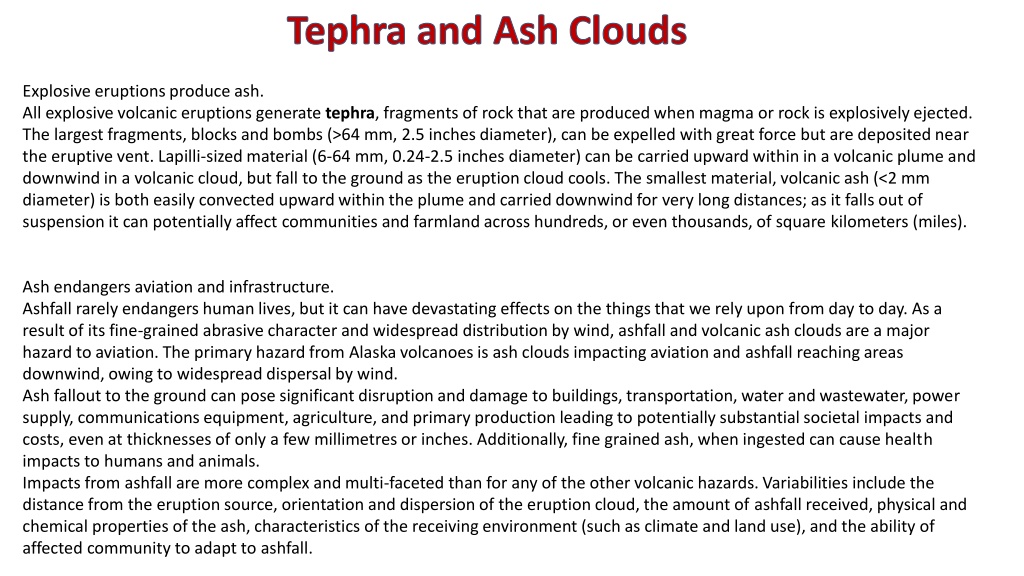


![Read⚡ebook✔[PDF] Io After Galileo: A New View of Jupiter's Volcanic Moon (Sprin](/thumb/21612/read-ebook-pdf-io-after-galileo-a-new-view-of-jupiter-s-volcanic-moon-sprin.jpg)



